Abstract
There is considerable evidence to suggest that the identification and treatment of dyslipidaemia will reduce the risk of premature CHD, i.e. before the age of 65. Diagnosis of the cause of raised plasma lipid levels will enable appropriate decisions to be taken with regard to management. The cornerstone of treatment is nutritional counselling and attention to other major risk factors for CHD, particularly smoking and hypertension. For a small percentage of patients with severe hyperlipidaemia drug therapy is indicated. Appropriate drug choices need to be made based on the particular lipid abnormality to be treated. In general those patients with clinical vascular disease are treated more aggressively than those where the aim is primary prevention. More research is needed to determine individual risk more precisely and to allow proper targeting of therapy. Genetic factors, qualitative changes in lipoproteins, lipoprotein (a), fibrinogen, and other coagulation and thrombotic factors are likely to be important in individual risk assessment. There is no doubt that more information is needed from prospective studies of lipid-lowering therapy in terms of risk benefit for affected individuals. Hopefully the major studies currently underway will fill some of the gaps in our knowledge. Until then aggressive therapy with drugs should be reserved for those at highest risk where the benefit is likely to be greatest.
Full text
PDF
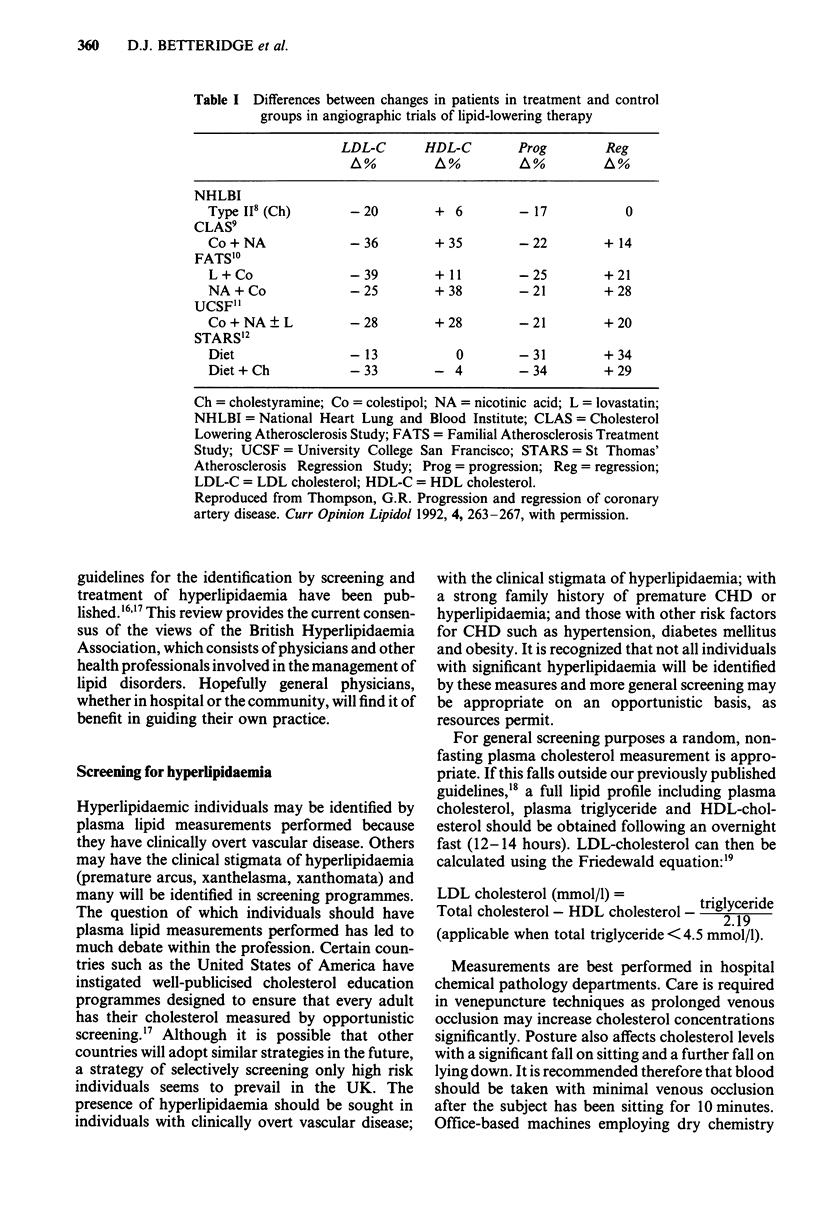
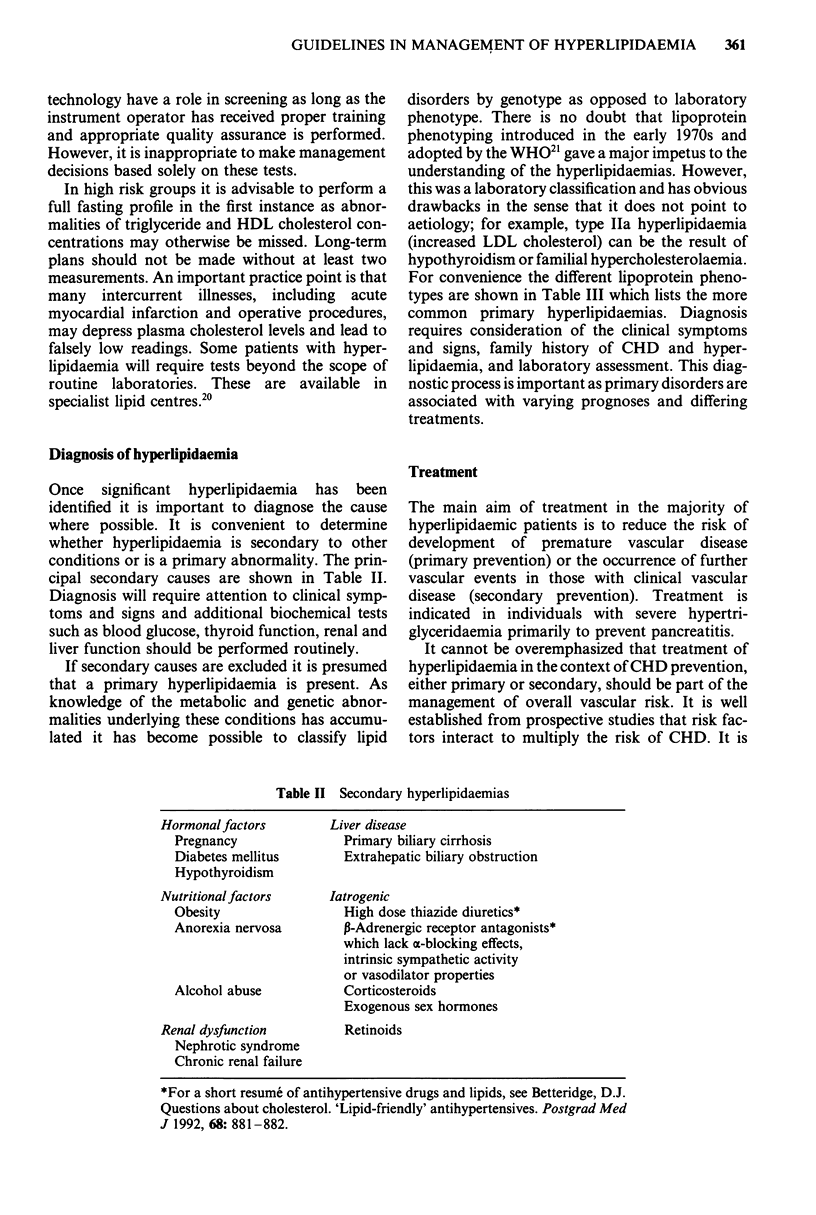
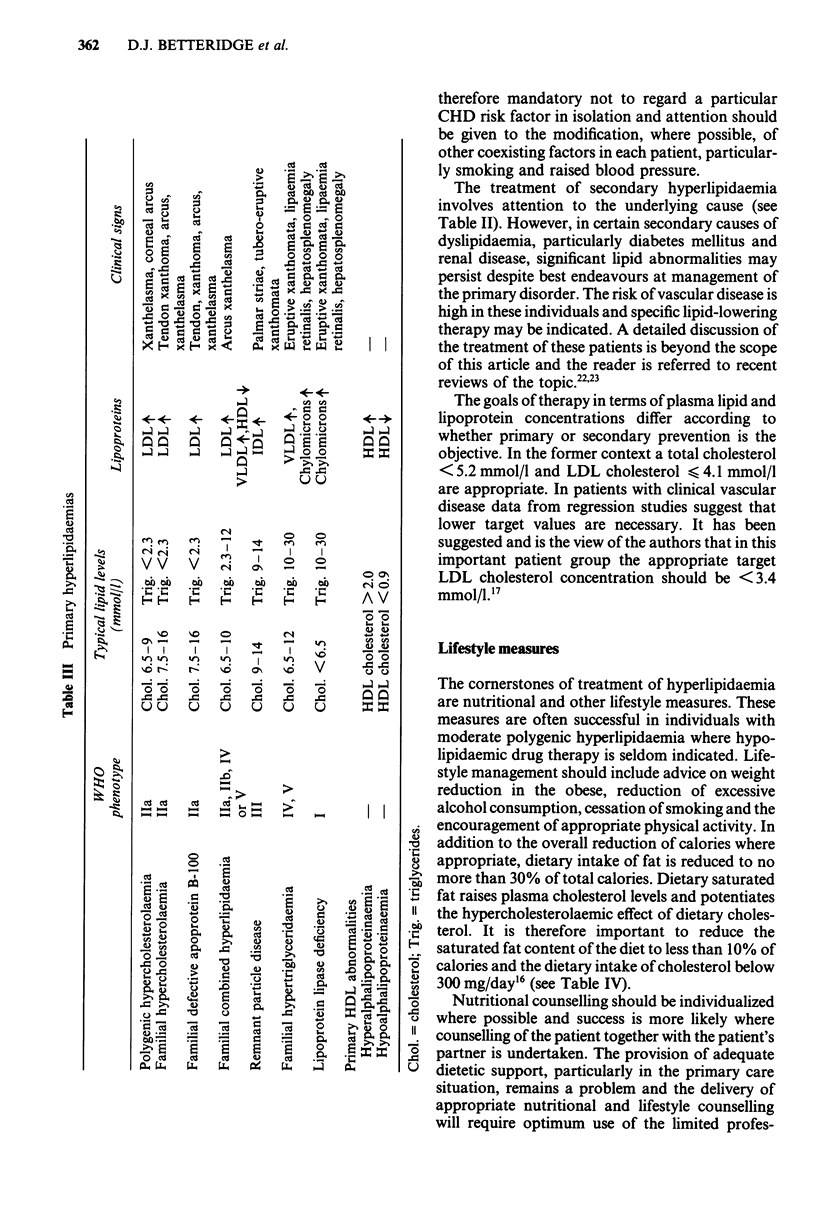
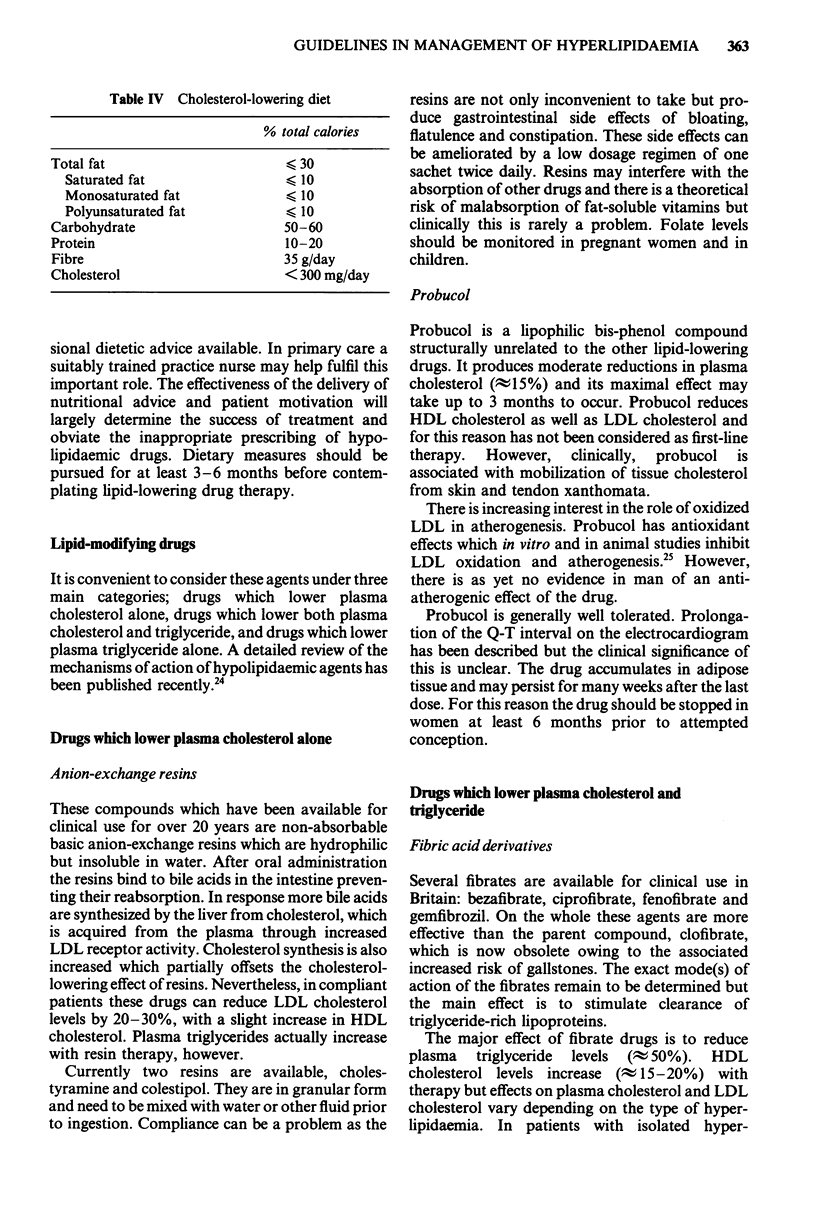
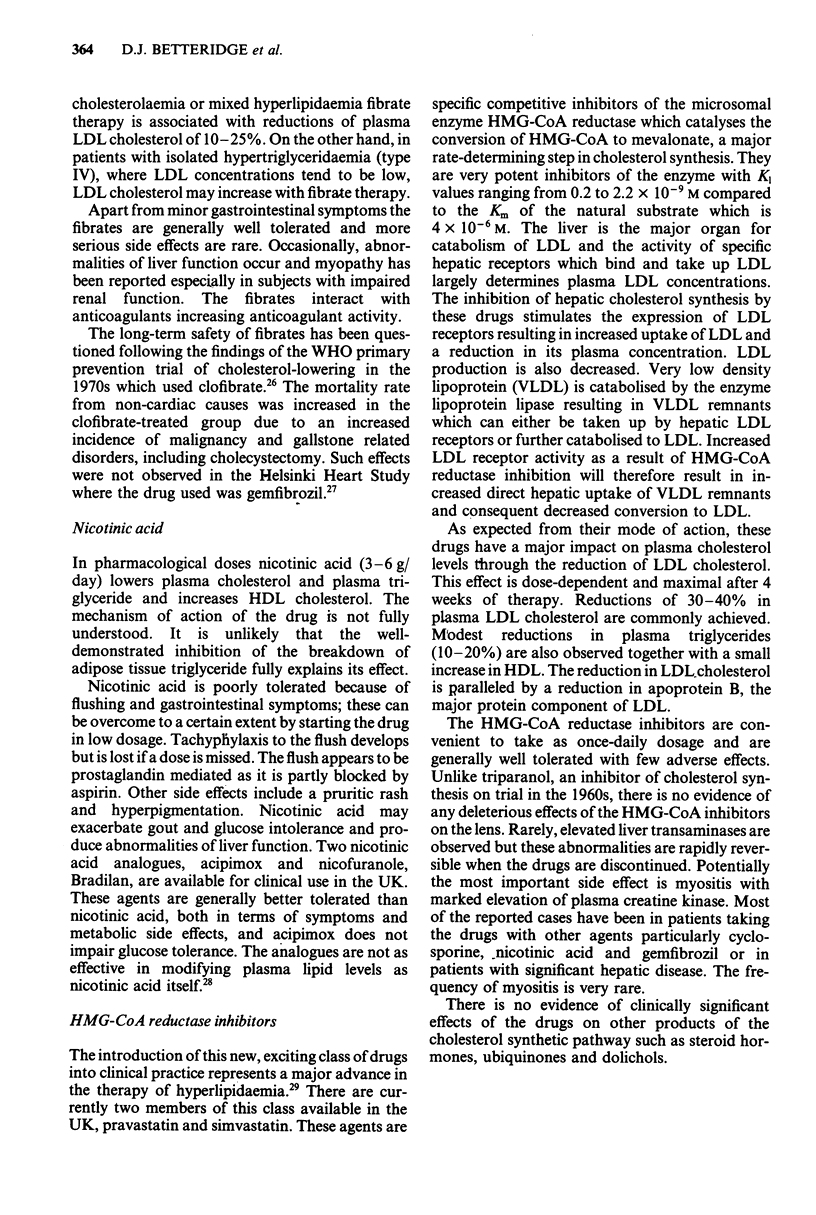
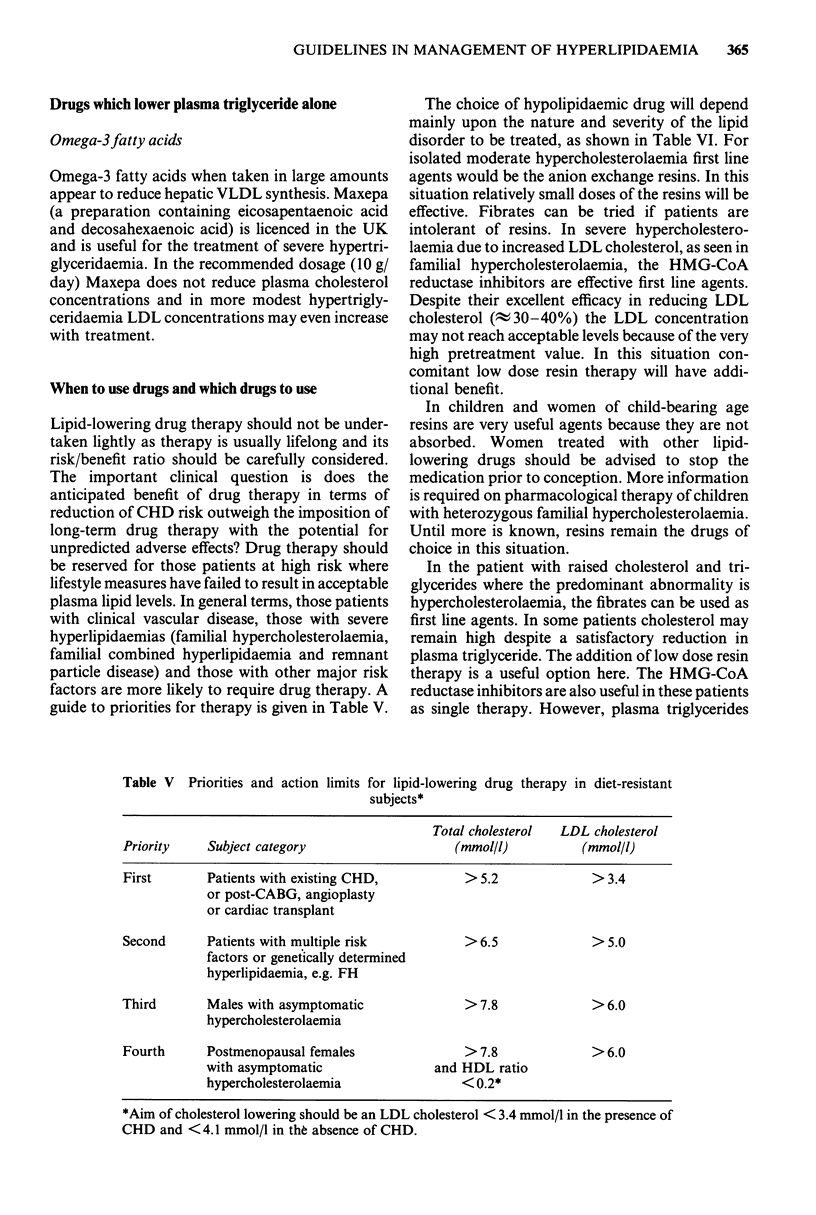
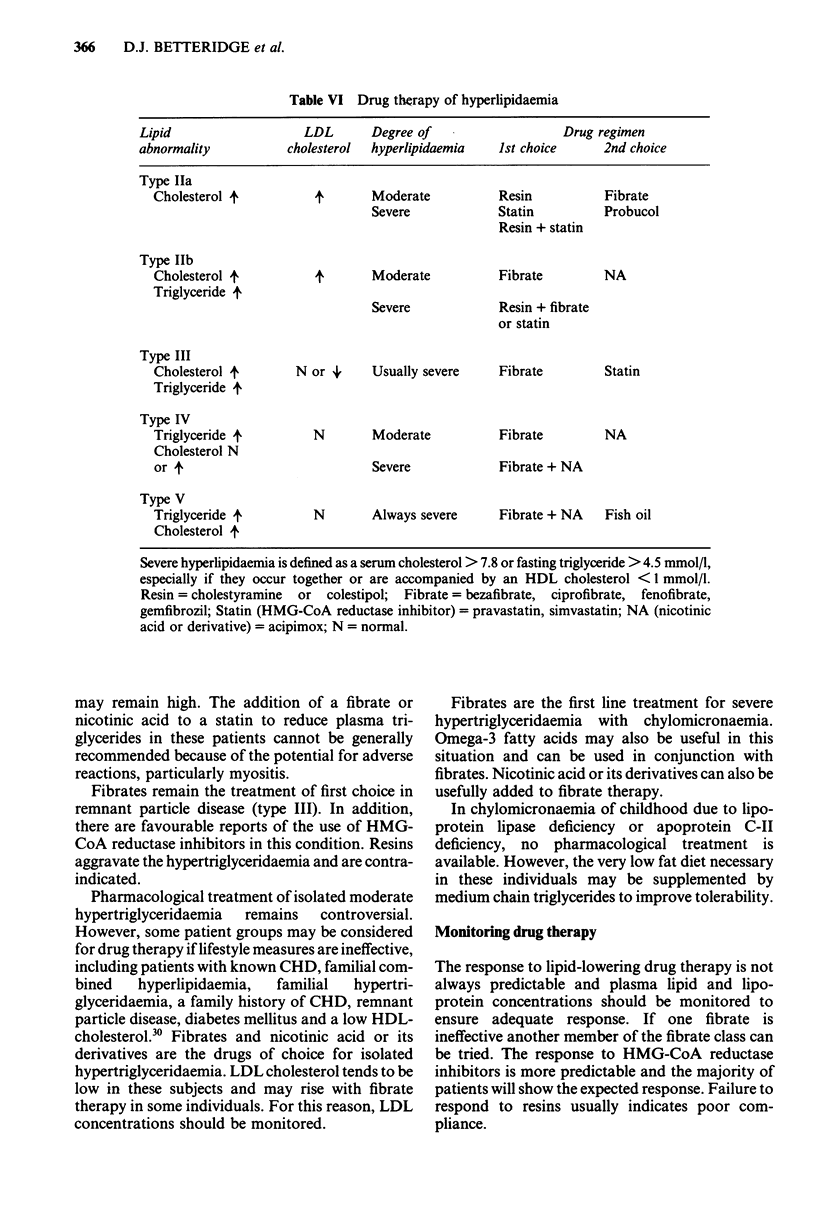
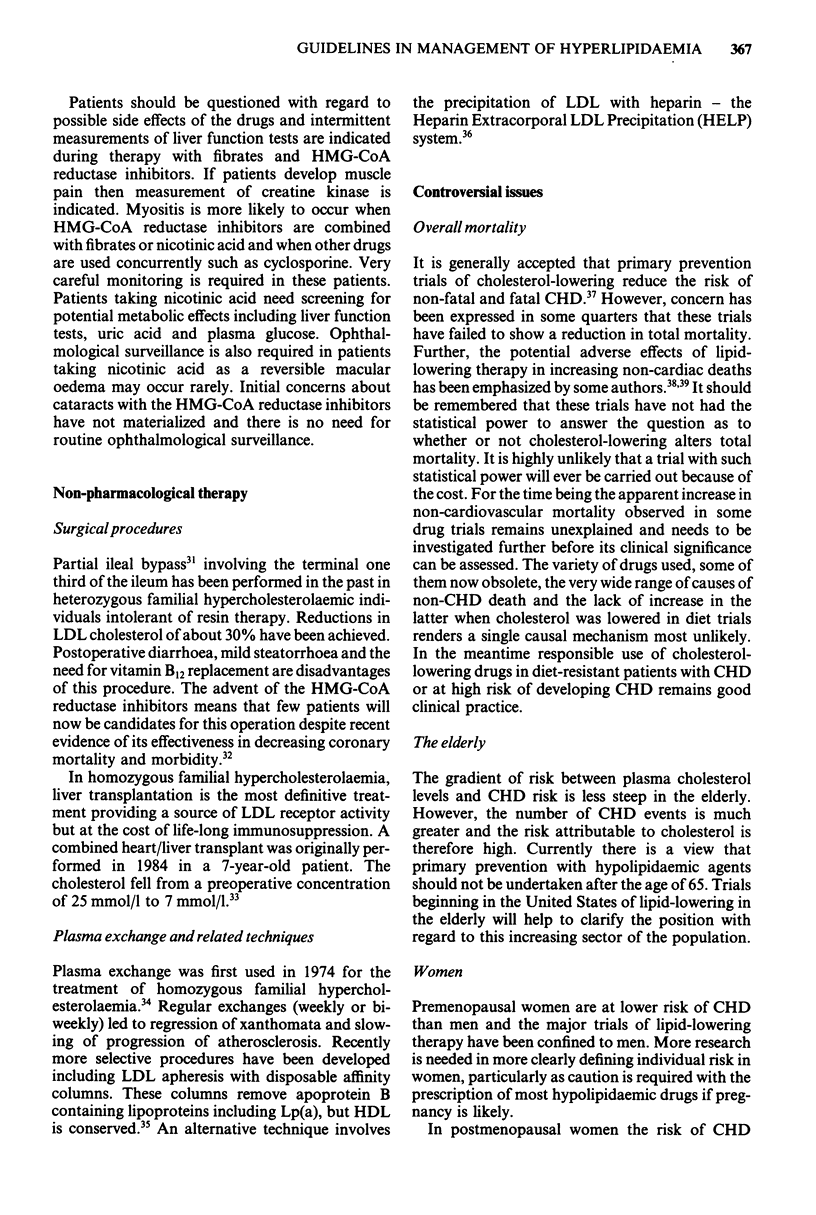
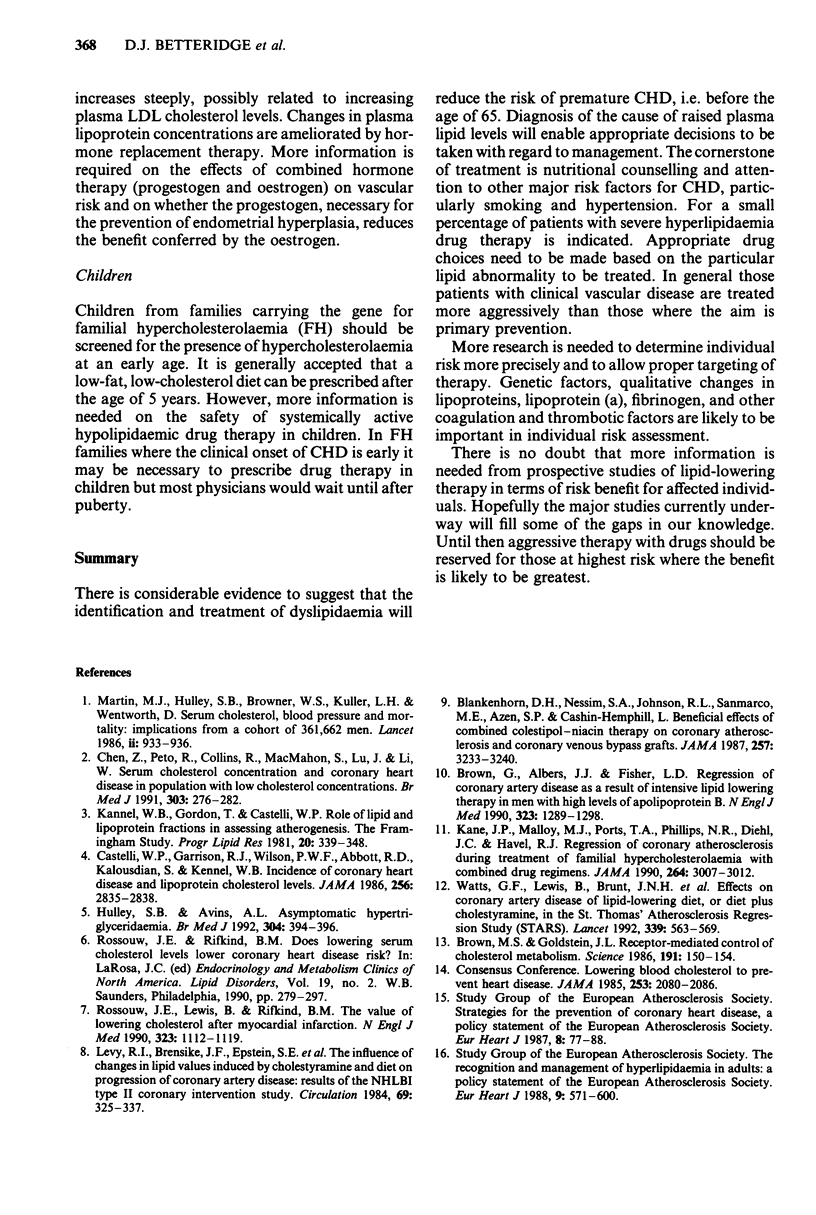
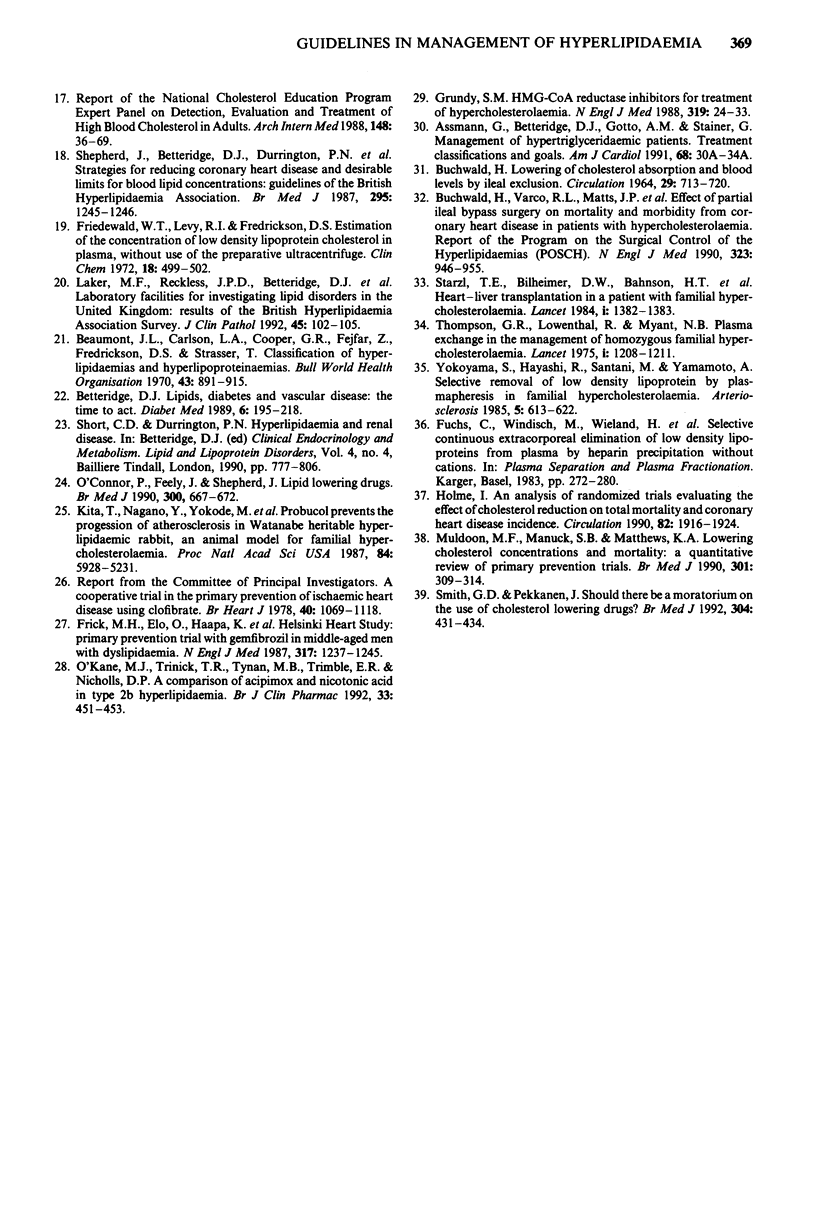
Selected References
These references are in PubMed. This may not be the complete list of references from this article.
- Assmann G., Betteridge D. J., Gotto A. M., Jr, Steiner G. Management of hypertriglyceridemic patients. A. Treatment classifications and goals. Am J Cardiol. 1991 Jul 24;68(3):30A–34A. doi: 10.1016/0002-9149(91)90858-i. [DOI] [PubMed] [Google Scholar]
- BUCHWALD H. LOWERING OF CHOLESTEROL ABSORPTION AND BLOOD LEVELS BY ILEAL EXCLUSION. EXPERIMENTAL BASIS AND PRELIMINARY CLINICAL REPORT. Circulation. 1964 May;29:713–720. doi: 10.1161/01.cir.29.5.713. [DOI] [PubMed] [Google Scholar]
- Beaumont J. L., Carlson L. A., Cooper G. R., Fejfar Z., Fredrickson D. S., Strasser T. Classification of hyperlipidaemias and hyperlipoproteinaemias. Bull World Health Organ. 1970;43(6):891–915. [PMC free article] [PubMed] [Google Scholar]
- Betteridge D. J. Lipids, diabetes, and vascular disease: the time to act. Diabet Med. 1989 Apr;6(3):195–218. doi: 10.1111/j.1464-5491.1989.tb01149.x. [DOI] [PubMed] [Google Scholar]
- Blankenhorn D. H., Nessim S. A., Johnson R. L., Sanmarco M. E., Azen S. P., Cashin-Hemphill L. Beneficial effects of combined colestipol-niacin therapy on coronary atherosclerosis and coronary venous bypass grafts. JAMA. 1987 Jun 19;257(23):3233–3240. [PubMed] [Google Scholar]
- Brown G., Albers J. J., Fisher L. D., Schaefer S. M., Lin J. T., Kaplan C., Zhao X. Q., Bisson B. D., Fitzpatrick V. F., Dodge H. T. Regression of coronary artery disease as a result of intensive lipid-lowering therapy in men with high levels of apolipoprotein B. N Engl J Med. 1990 Nov 8;323(19):1289–1298. doi: 10.1056/NEJM199011083231901. [DOI] [PubMed] [Google Scholar]
- Brown M. S., Goldstein J. L. Receptor-mediated control of cholesterol metabolism. Science. 1976 Jan 16;191(4223):150–154. doi: 10.1126/science.174194. [DOI] [PubMed] [Google Scholar]
- Buchwald H., Varco R. L., Matts J. P., Long J. M., Fitch L. L., Campbell G. S., Pearce M. B., Yellin A. E., Edmiston W. A., Smink R. D., Jr Effect of partial ileal bypass surgery on mortality and morbidity from coronary heart disease in patients with hypercholesterolemia. Report of the Program on the Surgical Control of the Hyperlipidemias (POSCH) N Engl J Med. 1990 Oct 4;323(14):946–955. doi: 10.1056/NEJM199010043231404. [DOI] [PubMed] [Google Scholar]
- Castelli W. P., Garrison R. J., Wilson P. W., Abbott R. D., Kalousdian S., Kannel W. B. Incidence of coronary heart disease and lipoprotein cholesterol levels. The Framingham Study. JAMA. 1986 Nov 28;256(20):2835–2838. [PubMed] [Google Scholar]
- Chen Z., Peto R., Collins R., MacMahon S., Lu J., Li W. Serum cholesterol concentration and coronary heart disease in population with low cholesterol concentrations. BMJ. 1991 Aug 3;303(6797):276–282. doi: 10.1136/bmj.303.6797.276. [DOI] [PMC free article] [PubMed] [Google Scholar]
- Davey Smith G., Pekkanen J. Should there be a moratorium on the use of cholesterol lowering drugs? BMJ. 1992 Feb 15;304(6824):431–434. doi: 10.1136/bmj.304.6824.431. [DOI] [PMC free article] [PubMed] [Google Scholar]
- Frick M. H., Elo O., Haapa K., Heinonen O. P., Heinsalmi P., Helo P., Huttunen J. K., Kaitaniemi P., Koskinen P., Manninen V. Helsinki Heart Study: primary-prevention trial with gemfibrozil in middle-aged men with dyslipidemia. Safety of treatment, changes in risk factors, and incidence of coronary heart disease. N Engl J Med. 1987 Nov 12;317(20):1237–1245. doi: 10.1056/NEJM198711123172001. [DOI] [PubMed] [Google Scholar]
- Friedewald W. T., Levy R. I., Fredrickson D. S. Estimation of the concentration of low-density lipoprotein cholesterol in plasma, without use of the preparative ultracentrifuge. Clin Chem. 1972 Jun;18(6):499–502. [PubMed] [Google Scholar]
- Grundy S. M. HMG-CoA reductase inhibitors for treatment of hypercholesterolemia. N Engl J Med. 1988 Jul 7;319(1):24–33. doi: 10.1056/NEJM198807073190105. [DOI] [PubMed] [Google Scholar]
- Holme I. An analysis of randomized trials evaluating the effect of cholesterol reduction on total mortality and coronary heart disease incidence. Circulation. 1990 Dec;82(6):1916–1924. doi: 10.1161/01.cir.82.6.1916. [DOI] [PubMed] [Google Scholar]
- Hulley S. B., Avins A. L. Asymptomatic hypertriglyceridaemia. BMJ. 1992 Feb 15;304(6824):394–396. doi: 10.1136/bmj.304.6824.394. [DOI] [PMC free article] [PubMed] [Google Scholar]
- Kane J. P., Malloy M. J., Ports T. A., Phillips N. R., Diehl J. C., Havel R. J. Regression of coronary atherosclerosis during treatment of familial hypercholesterolemia with combined drug regimens. JAMA. 1990 Dec 19;264(23):3007–3012. [PubMed] [Google Scholar]
- Kannel W. B., Gordon T., Castelli W. P. Role of lipids and lipoprotein fractions in atherogenesis: the Framingham study. Prog Lipid Res. 1981;20:339–348. doi: 10.1016/0163-7827(81)90067-9. [DOI] [PubMed] [Google Scholar]
- Kita T., Nagano Y., Yokode M., Ishii K., Kume N., Ooshima A., Yoshida H., Kawai C. Probucol prevents the progression of atherosclerosis in Watanabe heritable hyperlipidemic rabbit, an animal model for familial hypercholesterolemia. Proc Natl Acad Sci U S A. 1987 Aug;84(16):5928–5931. doi: 10.1073/pnas.84.16.5928. [DOI] [PMC free article] [PubMed] [Google Scholar]
- Laker M. F., Reckless J. P., Betteridge D. J., Durrington P. N., Miller J. P., Nicholls D. P., Shepherd J., Thompson G. R. Laboratory facilities for investigating lipid disorders in the United Kingdom: results of the British Hyperlipidaemia Association survey. J Clin Pathol. 1992 Feb;45(2):102–105. doi: 10.1136/jcp.45.2.102. [DOI] [PMC free article] [PubMed] [Google Scholar]
- Levy R. I., Brensike J. F., Epstein S. E., Kelsey S. F., Passamani E. R., Richardson J. M., Loh I. K., Stone N. J., Aldrich R. F., Battaglini J. W. The influence of changes in lipid values induced by cholestyramine and diet on progression of coronary artery disease: results of NHLBI Type II Coronary Intervention Study. Circulation. 1984 Feb;69(2):325–337. doi: 10.1161/01.cir.69.2.325. [DOI] [PubMed] [Google Scholar]
- Martin M. J., Hulley S. B., Browner W. S., Kuller L. H., Wentworth D. Serum cholesterol, blood pressure, and mortality: implications from a cohort of 361,662 men. Lancet. 1986 Oct 25;2(8513):933–936. doi: 10.1016/s0140-6736(86)90597-0. [DOI] [PubMed] [Google Scholar]
- Muldoon M. F., Manuck S. B., Matthews K. A. Lowering cholesterol concentrations and mortality: a quantitative review of primary prevention trials. BMJ. 1990 Aug 11;301(6747):309–314. doi: 10.1136/bmj.301.6747.309. [DOI] [PMC free article] [PubMed] [Google Scholar]
- O'Connor P., Feely J., Shepherd J. Lipid lowering drugs. BMJ. 1990 Mar 10;300(6725):667–672. doi: 10.1136/bmj.300.6725.667. [DOI] [PMC free article] [PubMed] [Google Scholar]
- O'Kane M. J., Trinick T. R., Tynan M. B., Trimble E. R., Nicholls D. P. A comparison of acipimox and nicotinic acid in type 2b hyperlipidaemia. Br J Clin Pharmacol. 1992 Apr;33(4):451–453. doi: 10.1111/j.1365-2125.1992.tb04067.x. [DOI] [PMC free article] [PubMed] [Google Scholar]
- Rossouw J. E., Lewis B., Rifkind B. M. The value of lowering cholesterol after myocardial infarction. N Engl J Med. 1990 Oct 18;323(16):1112–1119. doi: 10.1056/NEJM199010183231606. [DOI] [PubMed] [Google Scholar]
- Rossouw J. E., Rifkind B. M. Does lowering serum cholesterol levels lower coronary heart disease risk? Endocrinol Metab Clin North Am. 1990 Jun;19(2):279–297. [PubMed] [Google Scholar]
- Shepherd J., Betteridge D. J., Durrington P., Laker M., Lewis B., Mann J., Miller J. P., Reckless J. P., Thompson G. R. Strategies for reducing coronary heart disease and desirable limits for blood lipid concentrations: guidelines of the British Hyperlipidaemia Association. Br Med J (Clin Res Ed) 1987 Nov 14;295(6608):1245–1246. doi: 10.1136/bmj.295.6608.1245. [DOI] [PMC free article] [PubMed] [Google Scholar]
- Starzl T. E., Bilheimer D. W., Bahnson H. T., Shaw B. W., Jr, Hardesty R. L., Griffith B. P., Iwatsuki S., Zitelli B. J., Gartner J. C., Jr, Malatack J. J. Heart-liver transplantation in a patient with familial hypercholesterolaemia. Lancet. 1984 Jun 23;1(8391):1382–1383. doi: 10.1016/s0140-6736(84)91876-2. [DOI] [PMC free article] [PubMed] [Google Scholar]
- Thompson G. R., Lowenthal R., Myant N. B. Plasma exchange in the management of homozygous familial hypercholesterolaemia. Lancet. 1975 May 31;1(7918):1208–1211. doi: 10.1016/s0140-6736(75)92193-5. [DOI] [PubMed] [Google Scholar]
- Watts G. F., Lewis B., Brunt J. N., Lewis E. S., Coltart D. J., Smith L. D., Mann J. I., Swan A. V. Effects on coronary artery disease of lipid-lowering diet, or diet plus cholestyramine, in the St Thomas' Atherosclerosis Regression Study (STARS) Lancet. 1992 Mar 7;339(8793):563–569. doi: 10.1016/0140-6736(92)90863-x. [DOI] [PubMed] [Google Scholar]
- Yokoyama S., Hayashi R., Satani M., Yamamoto A. Selective removal of low density lipoprotein by plasmapheresis in familial hypercholesterolemia. Arteriosclerosis. 1985 Nov-Dec;5(6):613–622. doi: 10.1161/01.atv.5.6.613. [DOI] [PubMed] [Google Scholar]


